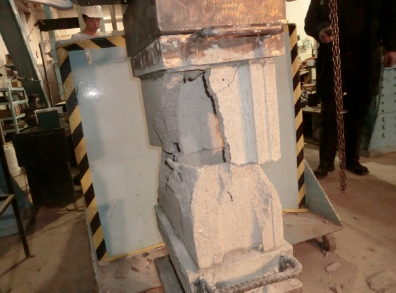1,2,3 Department of Civil and Environmental Engineering, University of Windsor, Windsor, ON, N9B 3P4, Canada, sdas@uwindsor.ca
4 Technical Services Engineer, Canadian Concrete Masonry Producers Association, Toronto, ON, M5M 3X0, Canada, bbstek@telus.net
ABSTRACT
A prism or prism specimen is a small segment of masonry intended to be representative of a larger masonry member, such as a wall. To determine masonry prism compressive strength, prisms are tested to failure by applying a monotonically increasing axisymmetric axial compression load. Multiplying the resulting prism compressive strengths by an appropriate “correction factor” to account for prism height and thickness establishes the specified compressive strength of the masonry. This strength is then used for designing masonry members having markedly similar materials and construction. Canadian standard CSA S304.1-04 suggests using prisms with a height-to-thickness ratio of five for determining the specified compressive strength, without the need for correction. A tall test-frame is required for testing such tall prisms. For convenience and economy, many labs prefer to use a prism with a smaller height-to-thickness ratio, preferably in the range of two (2) to three (3). It is generally believed that the height-to-thickness ratio has a significant effect on the apparent compressive strength of masonry prisms. Accordingly, for prisms with a height-to-thickness ratio less than five (5), S304.1-04 requires that the strength of an individual prism specimen be multiplied by a height-to-thickness correction factor (provided in Table D.1, S304.1-04), which is essentially a strength reduction factor, before calculating the specified compressive strength of the masonry used in design. However, Table D.1 shows that the correction factor for hollow concrete masonry construction does not change even if the height-to-thickness ratio changes in the range of five (5) to three (3). A few studies were undertaken in the past and one study found that the height-to-thickness ratio of hollow concrete masonry construction has no influence on its apparent compressive strength. Other studies have found that the compressive strength of hollow prisms indeed is influenced by the height-to-thickness ratio. Therefore, the current research project was completed to study the effect of height-to-thickness ratio on the compressive strength of hollow concrete prisms, to resolve conflicting results reported by previous research, and to verify h/t correction factors in CSA S304.1-04. The study found that the specified compressive strength of hollow prisms increases as the height-to-thickness ratio decreases. Hence, this study found that Table D.1 of CSA S304.1-04 is unconservative. This paper provides a summary of the literature review and discusses the test matrix, test method, and test results obtained from this study.
KEYWORDS: hollow concrete masonry, compressive strength, height-to-thickness ratio
223.pdf



